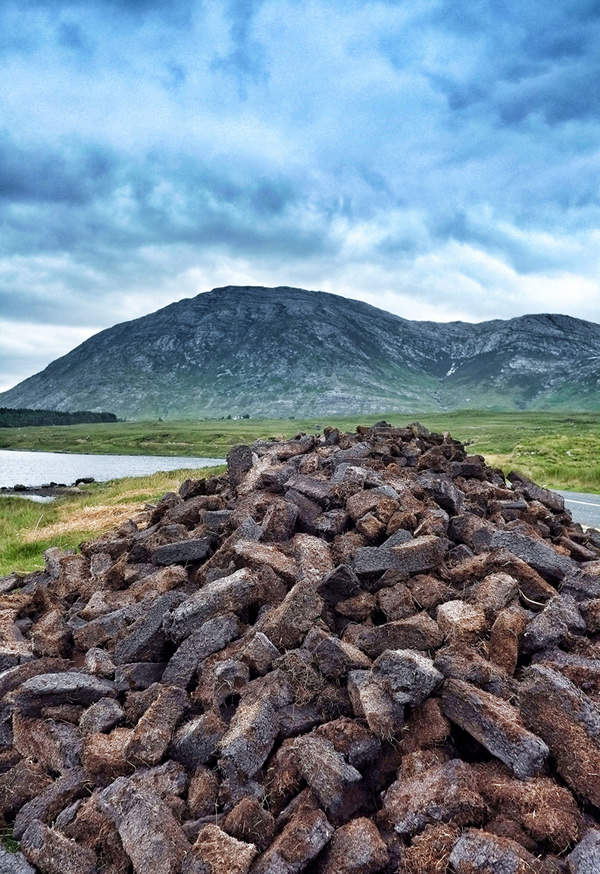 |
| Peat |
Peat is an unconsolidated accumulation of partly decomposed plant material, used as a fuel source, as a mulch, and for other uses.
Peat has been burned for heating and cooking or used as soil since the New Stone (Neolithic) Age, at least fifty-five hundred years ago.
Peat has many uses in agriculture, industry, and energy generation because of its organic chemical content and combustion properties. Although abundant in the middle latitudes of the Northern Hemisphere, it has been exploited as fuel primarily in northwestern Europe.
  |
Like crude oil and coal, peat is composed of the remains of dead organisms compressed underground, and it can be burned in home stoves and fireplaces or in factories and public power plants. Because peat is lightly compressed plant matter, it also works well as soil for agriculture and horticulture.
Worldwide, reserves of peat are comparable to those of other fossil fuels. For example, according to some estimates, resources in the United States surpass the combined potential energy yield of the nation’s petroleum and natural gas.
Peat forms in bogs, fens, sedge meadows, and some swamps as the debris of peat mosses (sphagnum), grasses, and sedges falls to the wet earth and becomes water-soaked.
In the absence of oxygen underwater, the plant matter and microorganisms compact without completely decomposing, forming soft, usually fibrous soils that are tan to black in color. The organic component, which includes cellulose, lignin, and some humus, is greater than 20 percent, and inmost peat soils plant fragments are visible. The ash content is less than 50 percent, usually as low as 10 percent.
Although the rate varies widely, in general a peat field increases in depth about three centimeters yearly. The bottoms of large peat fields are typically about ten thousand years old and can be as much as 50 meters below the surface, although 3-meter to 6-meter fields are common.
Geographical Distribution
 |
| Peat Geographical Distribution |
In the United States, Alaska containsmore than half the reserves, but peat is also abundant in Minnesota, Washington, Michigan, Wisconsin, Maine, New York, North Carolina, Florida, and Louisiana. Some countries well below the fortieth meridian have exploitable peat reserves, especially Indonesia, Cuba, and Israel.
Energy Potential and Uses
In northern Europe, peat has fueled fires since the New Stone Age. It provides one-half to two-thirds as much energy as coal, or about 3.8 megajoules per dry kilogram, yet gives off far fewer pollutants such as sulfur and ash. It can be converted into coke, charcoal, or a synthetic natural gas.
Only in Ireland, Russia, Finland, and Great Britain is peat employed primarily as a fuel, where in fact it is a traditional domestic resource.
Dried and pressed into briquettes, peat burns easily in fireplaces, stoves, and braziers. During the twentieth century the four countries burned increasing amounts of peat to generate electricity.
Because it has very limited wood and fossil fuel resources, Ireland has consumed about three times as much peat for power generation as for domestic heating, whereas the other countries primarily rely on coal for that purpose.
Agricultural and Horticultural Uses
The United States and Canada, as well as some European countries, process most of their peat as potting soil, lawn dressing, and soil conditioners.
Because they are much lighter and fluffier than mineral soils, peat preparations let water and oxygen penetrate easily and increase water retention, and so can be soil supplements or mulch. Throughout the United States commercial nurseries and homeowners apply such products to gardens and tree beds.
Farmers have raised grasses, clover, wild rice, cranberries, blueberries, strawberries, Christmas trees, and root and leafy vegetables on peat fields, and ranchers have used them for hay and grazing. However, peat fields are difficult to drain and clear and often remain wet, promoting rot and disease. They can be low in nutrients.
Other Uses
During the energy crisis of the 1970’s, researchers investigated peat as an alternative to petroleum, although few of the efforts resulted in commercial products because oil again became cheaper than peat for industrial chemicals in the 1980’s. Peat yields such mineral and organic substances as dyes, paraffin, naphtha, ammonium sulfate, acetic acid, ethyl and methyl alcohol, waxes, and phenols.
Combined with clay, it forms lightweight blocks for construction. It can remove heavy metals from industrial waste and can be turned into coke for iron processing or into charcoal for purifying water.
   |
With its mildly antibiotic properties, peat served as a lightweight surgical dressing during World War I. Another of peat’s well-known functions—and one of its oldest—is giving the smoky flavor to Scotch and Irish whiskeys as their malts slowly dry over open peat fires.
Because peat fields, once harvested, regenerate only after thousands of years, peat is not a renewable resource in any practical sense. Accordingly, intensive peat “mining” has caused concern among environmentalists.
They worry that the rapid exploitation of peat fields, especially in Ireland and Great Britain, may permanently destroy bogs and fens and thereby threaten the wildlife dependent upon wetland habitats.